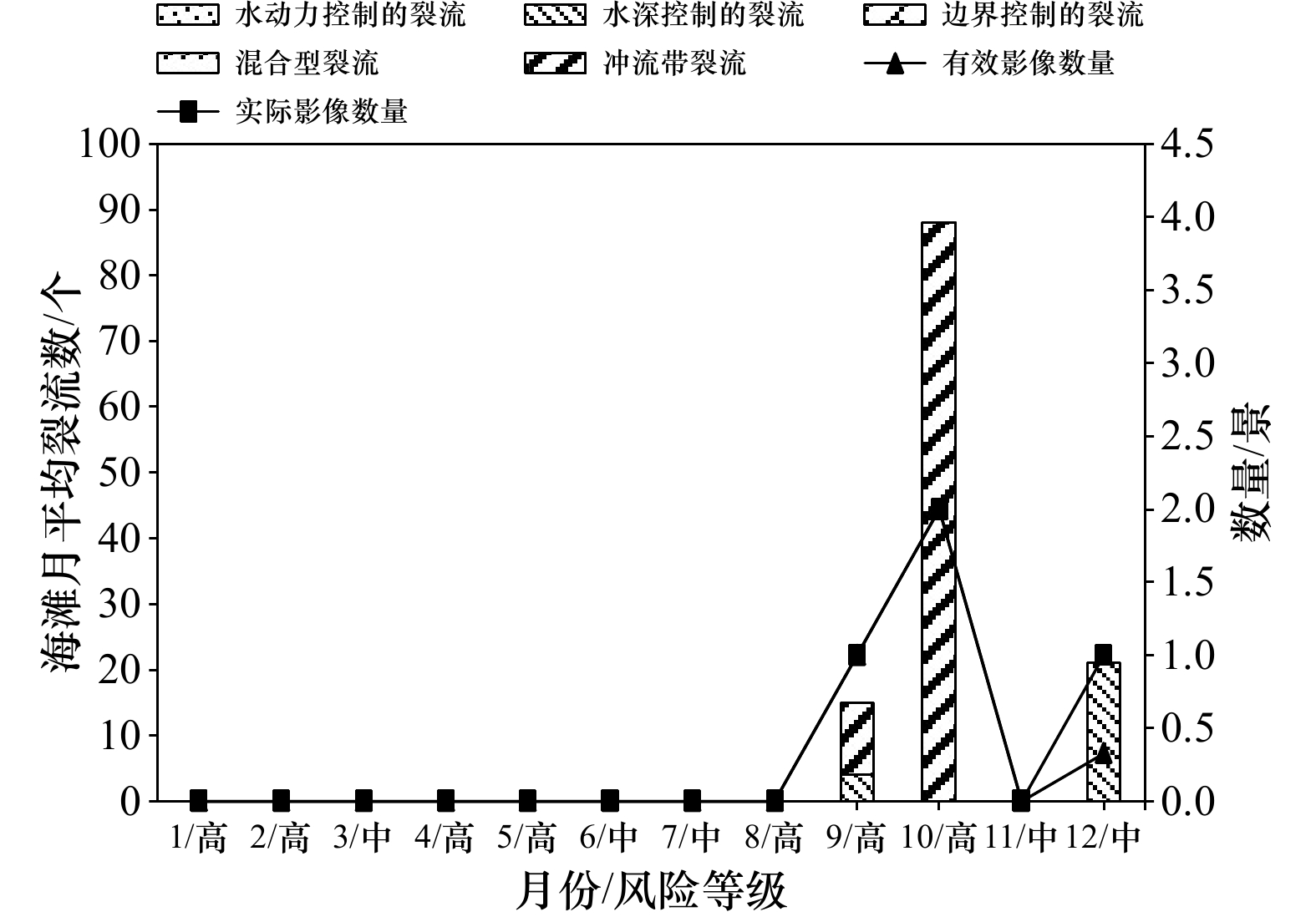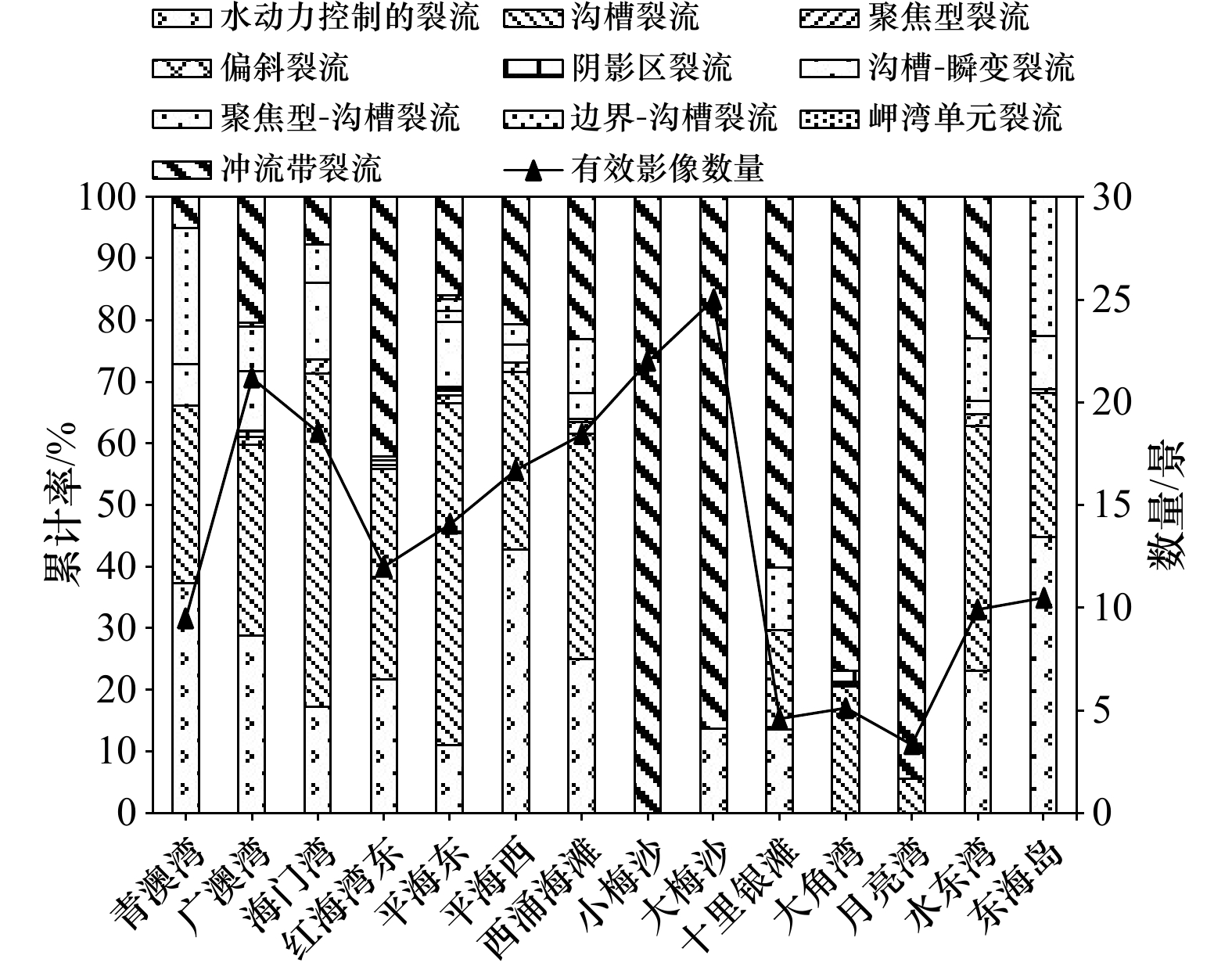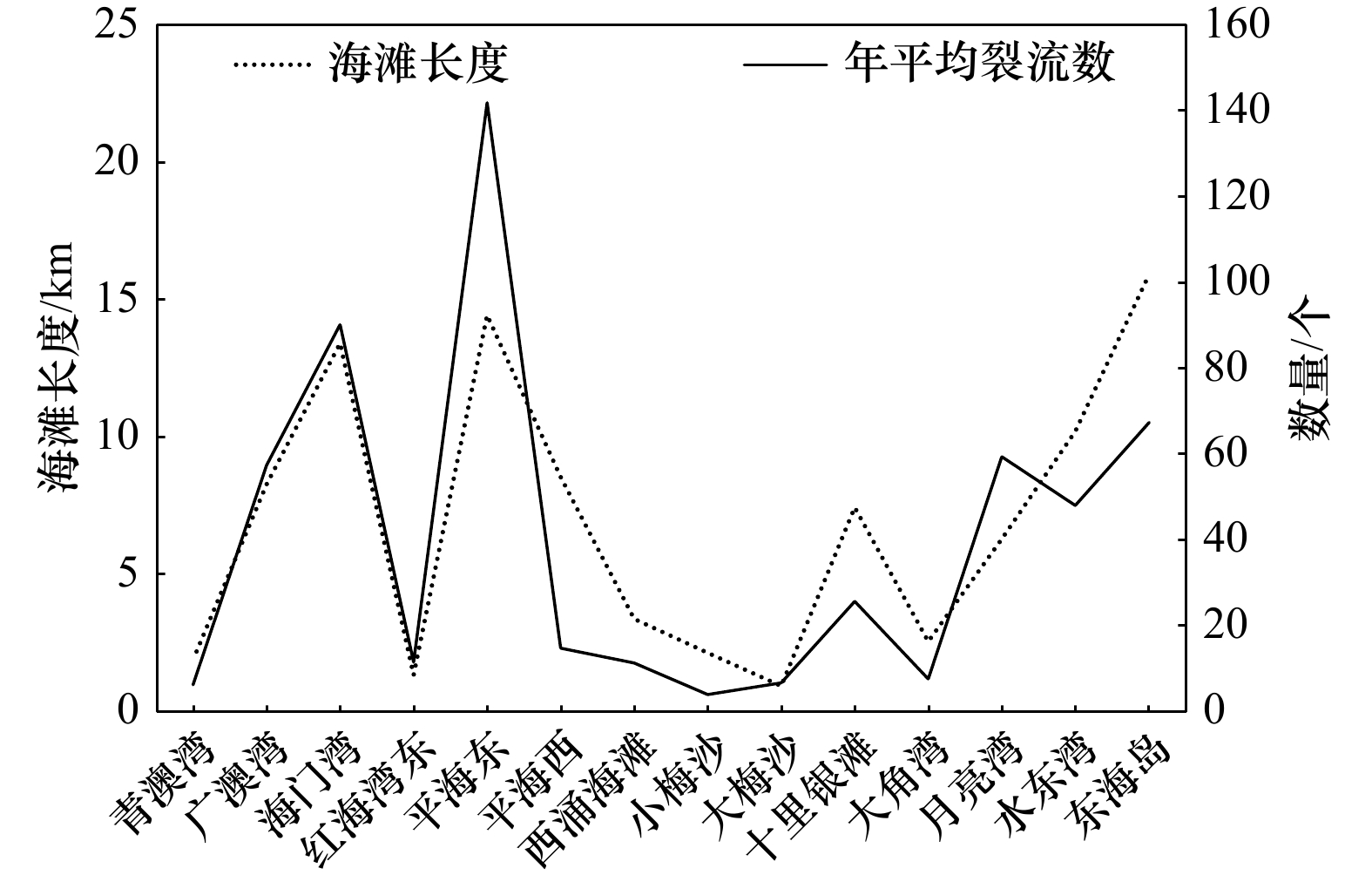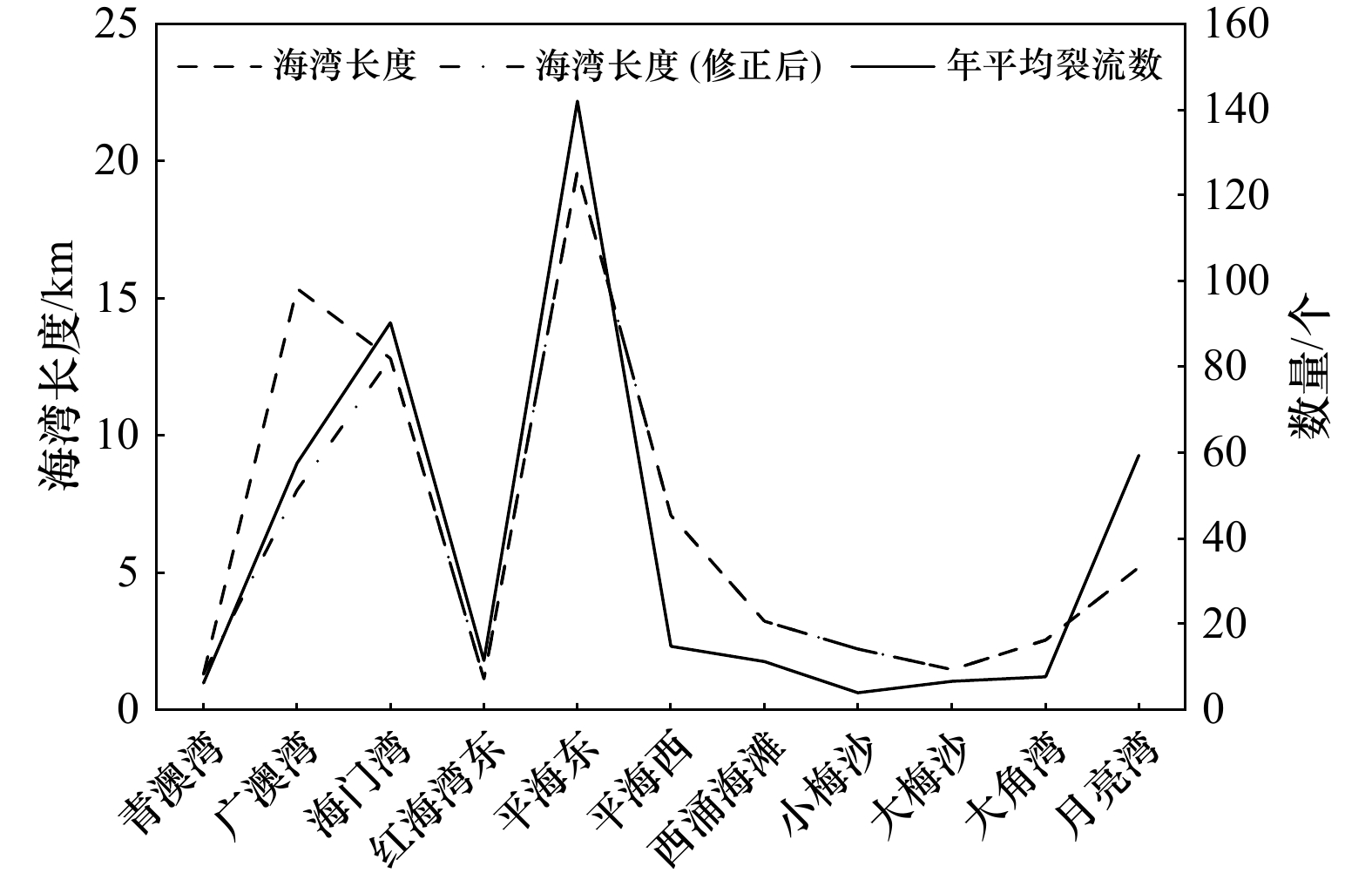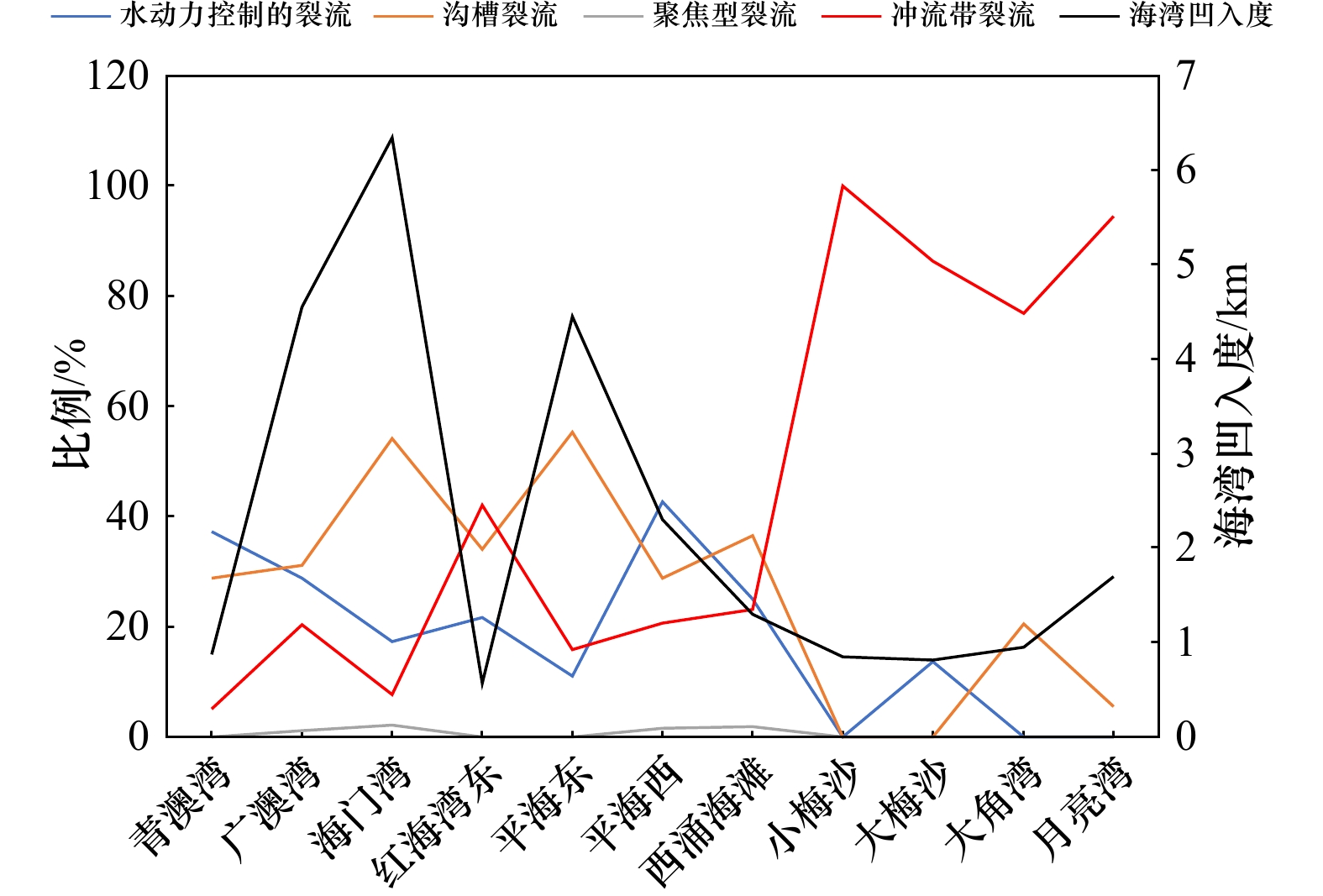Types and statistical analysis of rip currents at 14 beaches in the Guangdong Province
-
摘要: 裂流是沿海地区频发的一种高速离岸流。根据Castelle的裂流分类模型对广东省14个海滩的Google Earth影像进行了解译分类,对裂流分类模型在遥感影像中的应用进行了探讨。结果表明:在高风险月份,海滩裂流的组成较为单一,混合型裂流少,水深控制的裂流占据主导地位,裂流数量总体维持在较高水平;在中风险月份,水动力控制的裂流和混合型裂流的比例增加,水深控制的裂流仍然占有一定比例;在低风险月份,裂流很少出现,甚至无裂流发生。裂流的类型与海滩的状态密切相关。对于海湾中的海滩,海湾长度影响裂流的数量,海湾凹入度影响不同类型裂流的组成比例。考虑到实验条件的限制,这一规律需要后续结合实际地形地貌进行更细致和深入的研究和验证。按照本文解译标准得出的分类结果,与前人提出的裂流风险性评价模型吻合度较高,进一步说明了该解译标准的有效性,为今后对海滩裂流的研究和分类工作提供了一定的参考。Abstract: Rip current is a kind of high speed offshore current which occurs frequently in coastal. Based on Castelle’s rip current classification model, Google Earth images of 14 beaches in Guangdong Province were interpreted and classified, and the application of rip current classification model in remote sensing images was discussed. The results show that in high risk months, the composition of rip currents is relatively simple, the mixed rips are few, and the bathymetrically-controlled rip currents play a dominant role, and the number of rip currents remains at a high level. In the middle risk months, the proportion of hydrodynamically-controlled rip currents and mixed rips increases, while the proportion of bathymetrically-controlled rip currents still has a certain proportion. There is little or no rip currents in low-risk months. The structure of rip current is closely related to the state of beach. For the beach in the bay, the length of the bay affects the number of rip currents, and the concave degree of the bay affects the composition ratio of different types of rip currents. Considering the limitations of experimental conditions, this law needs to be further studied and verified in combination with the actual terrain and landform. The classification results obtained according to the interpretation criteria presented in this paper are in good agreement with the risk evaluation model proposed by previous authors, which further demonstrates the effectiveness of the interpretation criteria and provides some reference value for the future research and classification of rip currents.
-
Key words:
- rip current classification /
- visual interpretation /
- risk estimate /
- beach state
-
图 2 各类型裂流的特征影像
a.剪切不稳定裂流;b.瞬变裂流;c.沟槽裂流;d.聚焦型裂流;e.偏斜裂流;f.阴影区裂流;g.沟槽–瞬变裂流;h.聚焦型–沟槽裂流;i.边界–沟槽裂流;j.岬湾单元裂流;k.冲流带裂流
Fig. 2 Interpreting signs of various types of rip currents
a. Shear instability rips; b. flash rips; c. channel rip currents; d. focused rips; e. deflection rips; f. shadow rips; g. channel-flash rips; h. focus-channel rips; i. boundary-channel rips; j. embayed-cellular rips; k. swash rips
表 1 Castelle裂流分类类型表
Tab. 1 Castelle’s rip current classification types
类型 种类 水动力学控制的裂流 剪切不稳定裂流 瞬变裂流 水深控制的裂流 沟槽裂流 聚焦型裂流 边界控制的裂流 偏斜裂流 阴影区裂流 混合型裂流 沟槽−瞬变裂流 聚焦型−沟槽裂流 边界−沟槽裂流 岬湾单元裂流 表 2 影像各类型裂流解译判释表
Tab. 2 Interpretation of various types of rip currents in images
种类 解译标准 剪切不稳定裂流 位于沿岸均匀的开阔海滩,波浪高度倾斜入射,形成离岸的裂流头和狭窄的裂流颈,或物质离岸输移使颜色变深 瞬变裂流 位于沿岸均匀的开阔海滩,波浪近垂直入射,形成离岸的裂流头和狭窄的裂流颈,或物质离岸输移使颜色变深 沟槽裂流 沟槽切割沙坝或阶地并在开阔海滩上规律性地呈现;沟槽两侧波浪破碎形成白沫,影像上表现为白色 聚焦型裂流 入射波峰线由海向岸逐渐弯曲成韵律状,沿岸有白沫规律性凸起,在凸起附近有物质离岸输移使颜色变深 偏斜裂流 波浪从刚性边界迎风面入射,物质离岸输移使颜色变深 阴影区裂流 波浪从刚性边界背风面入射,在边界处白沫断裂 沟槽–瞬变裂流 波浪近垂直入射,沟槽宽度很小,在沟槽附近有细小的离岸白沫 聚焦型–沟槽裂流 有两层白沫(双沙坝),外侧白沫相对不明显,内沙坝沟槽切割程度较深,沟槽宽度很大且呈现规律性分布 边界–沟槽裂流 位于刚性边界附近,有沟槽,沟槽两侧有白沫 岬湾单元裂流 海湾凹入度小于冲浪区宽度,海湾内白沫非常明显,在海岬两侧或中心有离岸白沫 冲流带裂流 有规律地形成在滩角处,呈细条状的白沫 表 3 基于地形动力指标的滨海旅游海滩裂流风险等级表
Tab. 3 Beach characteristics and rip risk level based on morphodynamic values
海滩组别 泥沙沉降参数 相对潮差 海滩类型 裂流风险 反射组 Ω<2 RTR<3 完全反射型(R) 低 RTR >7 低潮台地型(LTT) 低 3LRTR≤7 低潮台地裂流型(LTTR) 中 中间状态型 2≤Ω≤5 RTR <3 沿岸沙坝型(B) 高 3BRTR≤7 低潮冲流沙坝裂流型(LTBR) 高 消散型 Ω>5 RTR <3 沙坝消散型(BD) 中 3BRTR≤7 无沙坝消散型(NBD) 低 超消散型 Ω>2 RTR >7 平缓超消散型(UD) 低 表 4 14个海滩的影像统计
Tab. 4 Image statistics of 14 beaches
沙滩名称 图像数/景 无法识别/景 无裂流/景 有裂流/景 青澳湾 11 1 3 7 广澳湾 28 2 0 26 海门湾 26 1 1 24 红海湾东 12 0 1 11 平海东 26 4 2 20 平海西 23 2 3 18 西涌海滩 21 2 4 15 小梅沙 22 1 14 7 大梅沙 27 1 14 7 十里银滩 6 0 2 4 大角湾 7 1 1 5 月亮湾 4 0 0 4 水东湾 13 1 0 12 东海岛 23 1 6 16 合计 249 17 51 176 注:由于云量或光线等原因会造成某些影像无法识别。 表 5 实际影像数量和有效影像数量
Tab. 5 Actual image number and effective image number
海滩名称 实际影像数量/景 有效影像数量/景 青澳湾 10 9.47 广澳湾 26 21.18 海门湾 26 18.56 红海湾东 12 12 平海东 22 14.07 平海西 21 16.7 西涌海滩 19 18.43 小梅沙 22 22 大梅沙 26 25 十里银滩 6 4.59 大角湾 6 5.11 月亮湾 4 3.33 水东湾 12 9.9 东海岛 22 10.47 -
[1] 孟凡昌, 李本霞. 裂流的研究综述[J]. 海洋预报, 2017, 34(1): 82−89. doi: 10.11737/j.issn.1003-0239.2017.01.011Meng Fanchang, Li Benxia. Review on the study of the rip current[J]. Marine Forecasts, 2017, 34(1): 82−89. doi: 10.11737/j.issn.1003-0239.2017.01.011 [2] Reimnitz E, Toimil L J, Shepard F P, et al. Possible rip current origin for bottom ripple zones, to 30-m depth[J]. Geology, 1976, 4(7): 395−400. doi: 10.1130/0091-7613(1976)4<395:PRCOFB>2.0.CO;2 [3] Short A D. Rip-current type, spacing and persistence, Narrabeen Beach, Australia[J]. Marine Geology, 1985, 65(1/2): 47−71. [4] Li Zhiqiang. Rip current hazards in South China headland beaches[J]. Ocean & Coastal Management, 2016, 121: 23−32. [5] 陆旭, 张弛, 时健, 等. 我国海滩游客安全事故数据库和事故特征分析[J]. 海洋开发与管理, 2021, 38(6): 3−11. doi: 10.3969/j.issn.1005-9857.2021.06.001Lu Xu, Zhang Chi, Shi Jian, et al. Tourists accident database and accident characteristics of beach tourism in China[J]. Ocean Development and Management, 2021, 38(6): 3−11. doi: 10.3969/j.issn.1005-9857.2021.06.001 [6] Alvarez-Ellacuria A, Orfila A, Olabarrieta M, et al. A nearshore wave and current operational forecasting system[J]. Journal of Coastal Research, 2010(263): 503−509. [7] Austin M, Scott T, Brown J, et al. Temporal observations of rip current circulation on a macro-tidal beach[J]. Continental Shelf Research, 2010, 30(9): 1149−1165. doi: 10.1016/j.csr.2010.03.005 [8] Chen Qin, Kirby J T, Dalrymple R A, et al. Boussinesq modeling of wave transformation, breaking, and runup. II: 2D[J]. Journal of Waterway, Port, Coastal, and Ocean Engineering, 2000, 126(1): 48−56. doi: 10.1061/(ASCE)0733-950X(2000)126:1(48) [9] Kim I C, Lee J L, Lee J Y. Verification of rip current simulation using a two-dimensional predictive model, HAECUM[J]. Journal of Coastal Research, 2013, 65(sp1): 726−730. [10] 张尧, 刘旭楠, 董肇伟, 等. 我国典型滨海旅游区裂流灾害评估调查及风险管理动态[J]. 海洋开发与管理, 2018, 35(7): 16−25. doi: 10.3969/j.issn.1005-9857.2018.07.003Zhang Yao, Liu Xunan, Dong Zhaowei, et al. Technical assessment and public warning of the rip current for China's typical coastal tourism[J]. Ocean Development and Management, 2018, 35(7): 16−25. doi: 10.3969/j.issn.1005-9857.2018.07.003 [11] Lin H, Hwang I, Shen S. The changes at long time scale on the beach type and rip current of the Fulong Beach in the north coast of Taiwan[J]. Journal of Geography Research, 2009, 50: 47−65. [12] Lin H, Hwang I, Shen S. The short-term change on the beach type and rip current of the Fulong Beach in the north coast of Taiwan[J]. Journal of Geographical Science, 2011, 61: 57−80. [13] Maryan C, Hoque T, Michael C, et al. Machine learning applications in detecting rip channels from images[J]. Applied Soft Computing, 2019, 78: 84−93. doi: 10.1016/j.asoc.2019.02.017 [14] De Silva A, Mori I, Dusek G, et al. Automated rip current detection with region based convolutional neural networks[J]. Coastal Engineering, 2021, 166: 103859. doi: 10.1016/j.coastaleng.2021.103859 [15] Shepard F P. Undertow, rip tide or “rip current”[J]. Science, 1936, 84(2173): 181−182. doi: 10.1126/science.84.2173.181 [16] Long J W, Özkan-Haller H T. Offshore controls on nearshore rip currents[J]. Journal of Geophysical Research:Oceans, 2005, 110(C12): C12007. doi: 10.1029/2005JC003018 [17] Dalrymple R A. Rip currents and their causes[C]//16th International Conference on Coastal Engineering. Hamburg, Germany: American Society of Civil Engineers, 1978: 1414−1427. [18] Shepard F P, Emery K O, La Fond E C. Rip currents: a process of geological importance[J]. The Journal of Geology, 1941, 49(4): 337−369. doi: 10.1086/624971 [19] Shepard F P, Inman D L. Nearshore circulation[R]. Scripps Institution of Oceanography La Jolla Calif, 1951. [20] Short A D, Brander R W. Regional variations in rip density[J]. Journal of Coastal Research, 1999, 15(3): 813−822. [21] Short A D. Australian rip systems-friend or foe?[J]. Journal of Coastal Research, 2007, SI 50: 7−11. [22] Wright L D, Cowell P J, Coffey F C. Nearshore Oceanography and Morphodynamics of the Broken Bay-Palm Beach Region, N. S. W. : Implications for Offshore Dredging[M]. Coastal Studies Unit, Department of Geography, University of Sydney, 1980. [23] Wind H G, Vreugdenhil C B. Rip-current generation near structures[J]. Journal of Fluid Mechanics, 1986, 171: 459−476. doi: 10.1017/S0022112086001520 [24] Dalrymple R A, MacMahan J H, Reniers A J H M, et al. Rip currents[J]. Annual Review of Fluid Mechanics, 2011, 43: 551−581. doi: 10.1146/annurev-fluid-122109-160733 [25] Castelle B, Scott T, Brander R W, et al. Rip current types, circulation and hazard[J]. Earth-Science Reviews, 2016, 163: 1−21. doi: 10.1016/j.earscirev.2016.09.008 [26] Wright L D, Short A D, Green M O. Short-term changes in the morphodynamic states of beaches and surf zones: an empirical predictive model[J]. Marine Geology, 1985, 62(3/4): 339−364. [27] Masselink G, Short A D. The effect of tide range on beach morphodynamics and morphology: a conceptual beach model[J]. Journal of Coastal Research, 1993, 9(3): 785−800. [28] 李志强. 基于地形动力学的华南海滩裂流风险研究[J]. 热带海洋学报, 2015, 34(1): 8−14. doi: 10.3969/j.issn.1009-5470.2015.01.002Li Zhiqiang. Study on the rip current hazard of South China beaches based on beach morphodynamics[J]. Journal of Tropical Oceanography, 2015, 34(1): 8−14. doi: 10.3969/j.issn.1009-5470.2015.01.002 [29] 李志强, 朱雅敏. 基于地形动力学的海滩裂流安全性评价——以三亚大东海为例[J]. 热带地理, 2015, 35(1): 96−102.Li Zhiqiang, Zhu Yamin. Beach safety evaluation based on rip current morphodynamic: a case study of Dadonghai of Sanya, China[J]. Tropical Geography, 2015, 35(1): 96−102. [30] 李志强, 陈杏文. 湛江东海岛裂流风险评价[J]. 海洋开发与管理, 2016, 33(S2): 73−78.Li Zhiqiang, Chen Xingwen. Rip Current risk at the beach of Donghai Island, Zhanjiang, China[J]. Ocean Development and Management, 2016, 33(S2): 73−78. [31] 张尧, 刘旭楠, 刘强, 等. 华南休闲海滩沙坝触发的裂流风险及特征研究[J]. 海洋学报, 2020, 42(9): 9−21.Zhang Yao, Liu Xunan, Liu Qiang, et al. Study on the risk and characteristics of rip currents over sandbars at South China’ s recreational beaches[J]. Haiyang Xuebao, 2020, 42(9): 9−21. [32] 广东省裂流排查工作小组. 广东省重点滨海旅游区裂流灾害风险排查报告[R]. 广州: 国家海洋局南海预报中心, 2018.Guangdong Provincial Working Group for Rip Current Investigation. Risk investigation report of rip current disaster in key coastal tourism areas of Guangdong Province[R]. Guangzhou: South China Sea Marine Prediction Center, State Oceanic Administration, 2018. [33] Wright L D, Short A D. Morphodynamic variability of surf zones and beaches: a synthesis[J]. Marine Geology, 1984, 56(1/4): 93−118. [34] Brander R, Scott T. Science of the rip current hazard[M]//Tipton M, Wooler A. The Science of Beach Lifeguarding. Boca Raton: CRC Press, 2016: 67−85. [35] Arozarena I, Houser C, Echeverria A G, et al. The rip current hazard in Costa Rica[J]. Natural Hazards, 2015, 77(2): 753−768. doi: 10.1007/s11069-015-1626-9 [36] Brighton B, Sherker S, Brander R, et al. Rip current related drowning deaths and rescues in Australia 2004–2011[J]. Natural Hazards and Earth System Sciences, 2013, 13(4): 1069−1075. doi: 10.5194/nhess-13-1069-2013 [37] Gensini V A, Ashley W S. An examination of rip current fatalities in the United States[J]. Natural Hazards, 2010, 54(1): 159−175. doi: 10.1007/s11069-009-9458-0 [38] Gallop S L, Woodward E, Brander R W, et al. Perceptions of rip current myths from the central south coast of England[J]. Ocean & Coastal Management, 2016, 119: 14−20. -




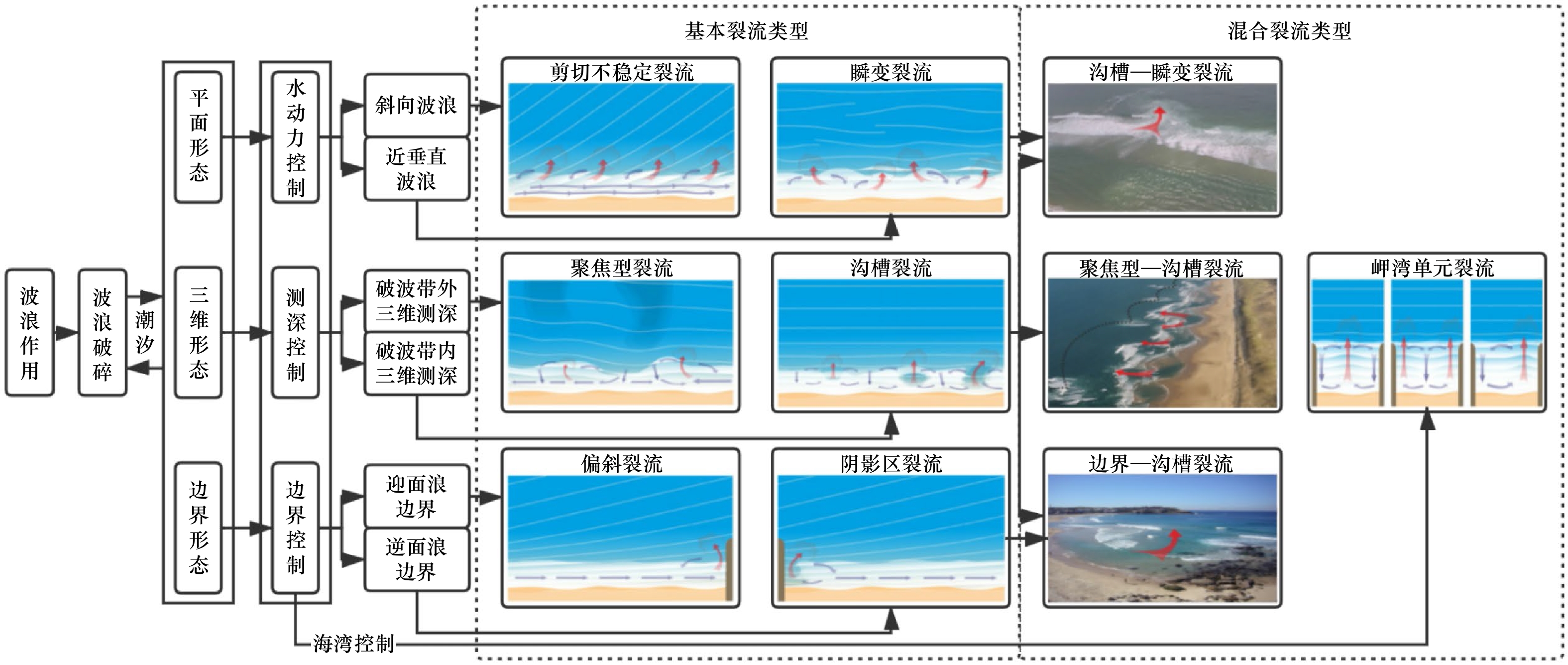
 下载:
下载:




